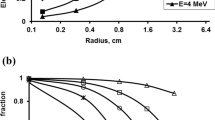Abstract
According to thereciprocity law, the total dose absorbed in a specimen irradiated by a point source can be inferred from the reciprocal situation, where the absorber is replaced by a source of the same shape and the radiation is measured at the position of the original point source.
In this paper, for a spherical source of homogeneous radioactive material with absorption coefficient μ1, we calculate the intensity of radiation (or flux) at a pointP, as well as the intensity which would be found at the same point if μ1 were zero. The ratio between these two quantities is denoted byk. We assume throughout that absorption follows the simple exponential law.
Self-absorption can also be characterized by the numberv, which is defined as the ratio between the total radiation current flowing through the surface of the source and the total current obtained if there were no absorption.
For a homogeneous spherical source in a nonabsorbing medium it is shown that the quantityk becomes equal tov if the distance between the pointP and the center of the sphere is sufficiently large. This fact was used by W. K. Sinclair in estimating an absorption coefficient from his experimental results.
We also derive an expression for the self-absorption ratio,v, of acylindrical source. In the limiting case of an infinitely long cylinder our result coincides with an equation previously found by S. Kushneriuk.
Similar content being viewed by others
Literature
Bromwich, T. J. I'A. 1947.An Introduction to the Theory of Infinite Series, 2nd edition. London: MacMillan Co.
Holuba, M. 1937. “Über den Einfluss der Absorption im Innern eines radioaktiven Präparates auf die ausgesendete Strahlung.”Akad. d. Wiss., Wien, Sitzungsberichte, Abt. 2A,146, 285–290.
Kellershohn, C., B. Herszberg, A. H. Morris, and Y. Bresson. 1964(?).Int. Jour. Appl. Radiation and Isotopes, in press.
King, L. V. 1912. “Absorption Problems in Radioactivity.”Phil. Mag.,23, 242–250.
Kovalev, E. E. 1958. “The Intensity of Gamma Radiation Emitted by a Cylindrical Source.”Intern. Jour. Appl. Radiation and Isotopes,3, 113–118.
Kushneriuk, S. 1947. “Absorption of Gamma Rays by Homogeneous Cylinders Containing Uniform Source Distributions.” National Research Council, Atomic Energy Project,Report TPI-46, Chalk River, Ontario.
Mayneord, M. V. 1945. “Energy Absorption. IV. The Mathematical Theory of Integral Dose in Radium Therapy.”Brit. Jour. Radiol.,18, 12–19.
Meyer, S., and E. von Schweidler. 1927.Radioaktivität. Berlin: Teubner.
Morris, A. H. 1964. “Self-Absorption in Radioactive Spheres.”Thesis; Department of Radiology, Yale University School of Medicine.
Sinclair, W. K. 1961. “Absorbed Dose in Externally Irradiated Biological Specimens. I. Co60 Gamma Radiation.”ANL-6464, Semiannual Report of Biological and Medical Research Division, Argonne National Laboratory, pp. 133–142.
— 1963. “Absorbed Dose in Biological Specimens Irradiated Externally with Cobalt-60 Gamma Radiation.”Radiation Research,20, 288–297.
Souttar, H. S. 1931. “On Fields of Radiation from Radon Seeds.”Brit. Jour. Radiol.,4, 681–689.
Tables of Sine, Cosine, and Exponential Integrals, Vol. I. 1940. Federal Works Agency, Work Projects Administration for the City of New York.
Taylor, J. J., and F. E. Obenshain. 1953. “Flux from Homogeneous Cylinders Containing Uniform Source Distributions.”Report WAPD-RM-213, Atomic Power Division, Westinghouse Electric Corporation, Pittsburgh, Pennsylvania.
Thirring, H. 1912. “Über den Einfluss der Absorption im Inneren eines radioaktiven Präparates auf die ausgesendete Strahlung.”Physik. Zeitschr.,13, 266–268.
Trucco, E. 1962. “Progress Report: A note on Self-Absorption and Reciprocity Law in Radiation Dosimetry.”ANL-6723, Semiannual Report of Biological and Medical Research Division, Argonne National Laboratory, pp. 16–27.
Trucco, E. 1963. “Self-Absorption and Reciprocity Law in Radiation Dosimetry; Calculation of Absorption Coefficient from Measured Intensities of Radiation.”ANL-6790, Semiannual Report of Biological and Medical Research Division, Argonne National Laboratory, pp. 11–14.
von Schweidler, E. 1912. “Über die Strahlung einer mit radioaktivem Material erfüllten Kugel.”Physik. Zeitschr.,13, 453–454.
Watson, G. N. 1945.Theory of Bessel Functions, 2nd edition. Cambridge: University Press; New York: Macmillan Co.
Whittaker, J. B. 1963. “The Dose-Rate from a Spherical Source with Self-Absorption.”Physics in Medicine and Biology, Vol.8, No. 3, 309–318.
Whyte, G. N. 1959.Principles of Radiation Dosimetry. New York: Wiley.
Author information
Authors and Affiliations
Additional information
This work was performed under the auspices of the U.S. Atomic Energy Commission.
Rights and permissions
About this article
Cite this article
Trucco, E. Self-absorption in spheres and cylinders of radioactive material. Bulletin of Mathematical Biophysics 26, 303–325 (1964). https://doi.org/10.1007/BF02484232
Received:
Issue Date:
DOI: https://doi.org/10.1007/BF02484232




